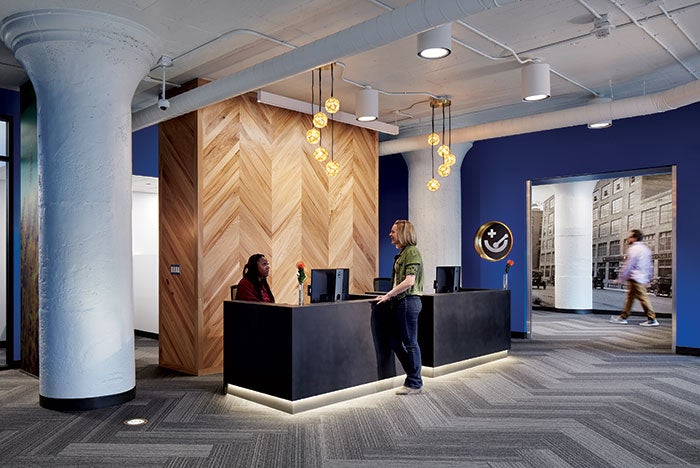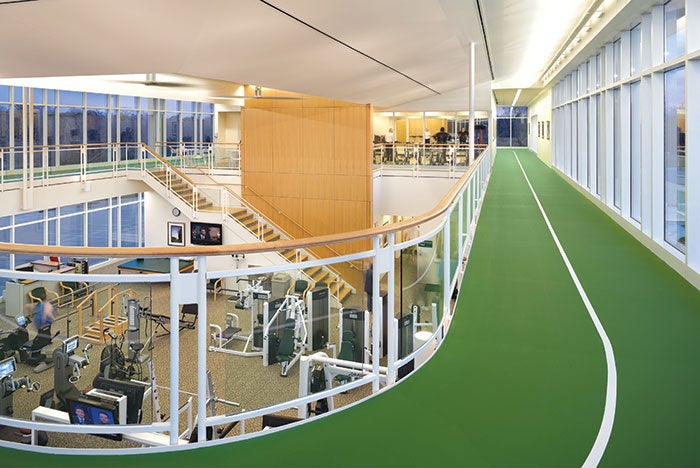Designing health care's new front door

The HCMC North Loop Clinic and Pharmacy includes primary care services, online scheduling, electronic health records and wellness programming tailored to the neighborhood’s younger demographics.
Once concentrated in a central hub, health care services are moving outward — into retail spaces, clinics, wellness centers, homes, schools and corporate spaces.
People are more likely to seek health care services if it is convenient, whether they live in rural, suburban or urban locations. By identifying underserved market segments, health care organizations are able to establish a front door to the system and direct patients to additional services as needed.
Through this outmigration of care focused on convenience, providers are offering the promise of better service and better health for an increasingly diverse population.
Driving factors
Several market factors are driving the outmigration of care and new approaches to clinic design:
Economics. As more people gain access to insurance, health care organizations are responding with new clinics and outpatient facilities to meet the growing demand for services and wellness programming.
Technology. Telemedicine is changing the way patients receive care, enabling remote diagnosis and treatment via laptop or tablet. Patients and health care organizations clearly have embraced this new technology, with a growing number of clinics adding telemedicine services.
Collaborative care. New care models also are reshaping the health care landscape. The collaborative medical home team includes primary care physicians, nurses, medical specialists, health coaches and other licensed care practitioners. Similarly, accountable care organizations (ACOs) include collaborative groups of doctors, hospitals and other health care providers who deliver high-quality service to Medicare patients.
Continuum of care. The health care field is moving away from a fee-for-service to fee-for-outcome model, with a greater emphasis on preventive and follow-up care. To achieve this, providers are identifying entry points into the system to manage population health along all life stages, from birth to end of life. Targeted access points help to keep the population healthy enough to avoid acute care hospitalization and help to treat former acute care patients with the right services to avoid costly readmissions.
Accessible locations
These factors have led to the development of a number of clinic entry points along the continuum of care, including the following venues:
You may also like |
| Designing Lean ambulatory care facilities |
| Micrhospitals built to fill community gaps |
| Four pre-development steps for microhospitals |
|
|
Retail/storefront settings. Many health care organizations are finding cost-effective solutions to their facility needs by converting former stores into clinics. This offers built-in benefits — these former stores are accessible to the community, offer ample parking and are connected to existing transportation networks.
For patients, retail conversions offer familiarity in their own neighborhood. Landlords welcome health care tenants because of the stability the clinic brings to the retail area. Retail-based clinics also increase foot traffic around the neighboring stores, allowing for potential increased revenue.
Retail spaces allow health care systems to efficiently establish presence within an underserved market. Consider the diverse patient types around a major city — the downtown central business district, surrounding neighborhoods and suburbs farther afield. Each area may have different demographics and health care needs, from office workers to young professionals in trendy neighborhoods to seniors in the suburbs.
Just outside downtown Minneapolis, for instance, Hennepin County Medical Center (HCMC), a Level I trauma center, recently opened a street-level, storefront clinic and full-service pharmacy in a renovated commercial building. Catering to the tech-savvy young professional crowd, the HCMC North Loop Clinic and Pharmacy includes primary care services, online scheduling, electronic health records and wellness programming tailored to the neighborhood’s younger demographics. The facility’s convenient location and visually appealing architecture is intended to reinforce lifelong wellness routines.

Scalability and adaptability can be seen in a number of changes between Phase 1 and Phase 2 of the plans for Hennepin County Medical Center – St. Anthony Village Clinic and Pharmacy.
Farther afield, HCMC opened another clinic set within the existing suburban strip mall, backed by an assisted-living facility. The Richfield Clinic and Pharmacy serves the neighborhood families of the first-ring suburb while creating a direct passage to HCMC’s comprehensive services. “Between the North Loop Clinic and our main [downtown] campus, we are able to meet every health care need of downtown residents, workers and visitors,” says Scott Wordelman, FACHE, senior vice president of ambulatory care and support services at HCMC. “People can stay in one system to get the full continuum of care, all located close to where they live or work.”
Microclinics. Also known as convenient care or walk-in clinics, microclinics are forecasted to expand dramatically in the near future. Many walk-in microclinics are located near the pharmacy section of big-box stores, but they also are showing up in storefronts on pedestrian streets. Some say that by 2020, pharmacy-based clinics will constitute the majority of primary care services in the nation. While most microclinics are not owned by health systems, commercial chains increasingly are looking for provider partners.
Microclinics fill a void in the health care system by making services accessible without an appointment, while still tying into the larger system by treating minor ailments and then referring patients to their primary care provider. Patients see these types of clinics as being convenient with extended hours and accessible locations. This type of care also allows for low-cost care, which is intriguing to many, especially underinsured patients.
About this article
This feature is one of a series of quarterly articles published by Health Facilities Management in partnership with the American College of Healthcare Architects.

From a health system perspective, this type of clinic brings patients into the system, including attracting and retaining younger patients. It also expands the primary care base, helping to balance the primary care provider shortage.
Wellness centers. Many health systems are integrating wellness centers into their brick-and-mortar portfolio. Wellness centers provide a means of improving the overall health of the communities they serve, while decreasing the total cost of care for the health system. From a patient’s perspective, they can enhance their health, clinical and fitness services — all offered by a single system at a convenient location.
A wellness center, while improving health, also can allow for congenial interaction, distinctly different from a commercial club. From the health system perspective, a wellness center expands the referral base in an effort to grow market share. This type of space also helps to reduce preventable diseases, supporting wellness and preventive care under a shared-risk model. This type of center also lends itself to most health systems’ missions to keep their communities healthy.
Wellness centers include community fitness centers, rehabilitation centers and spas. Wellness centers offer fitness equipment, classrooms and community rooms for diverse programming, from group fitness to health coaching, health education classes and community education. Services offered may include cardiac rehab, weight management, screenings, exercise classes, physical therapy and occupational medicine.
The East Texas Medical Center (ETMC) Olympic Center/Rehabilitation Services at Lake Palestine, for instance, includes such amenities as rehabilitation saltwater pools, running tracks, cardiovascular and strength-training equipment, aerobic and yoga studios, and weight training and massage therapy facilities. Lake Palestine is one of 10 ETMC wellness centers throughout Texas that provide outpatient physical therapy, cardiopulmonary rehabilitation, massage therapy, floor and aquatic group therapy as well as seminars and swimming lessons for all levels.
Planning considerations
Clinic design will continue to evolve to meet market needs and delivery methods, prompting the following guidelines for planning:

East Texas Medical Center Olympic Center/Rehabilitation Services at Lake Palestine includes an indoor track and strength training equipment.
Flexibility. To maximize exam room utilization, plan for a flexible universal platform that can be modified to meet the unique needs of different specialists. A flexible exam room, for instance, will include mobile furniture and supply carts that can be brought in as needed, allowing the room to change daily. Conference space, too, can be transformed easily into an infusion area or a teaching kitchen. Flexibility assures that the spaces can change in the short term to meet the immediate needs of the clinic.
Adaptability. Adaptability accommodates long-term changes. Within a smaller clinic, this may mean that the large group room can be transformed easily into four exam rooms if required. In a larger clinic setting, adaptability may mean that the building can accommodate such long-term changes as conversion of a medical office building into an ambulatory facility.
Scalability. Scalability responds to growth outside of the current walls of the built clinic. For build-out within a retail strip mall, this could mean that the plan can grow as the retail shop next door becomes available — basically building off what exists to accommodate new expansion. Within a larger clinic setting, this scalability may mean building out another complete care module in an adjoining space, seamlessly expanding the size of the building while maintaining operational flows for the rest of the facility.
For instance, in 2011, HCMC acquired 4,800 square feet within a strip mall to build out a new clinic for the St. Anthony community, about five miles east of the main HCMC Level I trauma center. The initial St. Anthony Village Clinic and Pharmacy allowed for six exam rooms and one procedure room, plus lab, radiology and outpatient pharmacy. It was a starting point for HCMC’s introduction within the new community.
This plan has served HCMC well for the past six years. With continued growth, HCMC is ready to expand into the adjacent rental spaces once occupied by a nail salon and a pizza restaurant. The new plan will be 7,560 square feet and will accommodate 13 exam rooms, one procedure room and a chiropractic room, while keeping the existing lab, radiology and outpatient pharmacy intact.
For the new plan to tie seamlessly into the existing layout, the design started by being flexible, adaptable and scalable. Some initial thoughts on planning included the scaling of the front-end spaces in Phase 1 to accommodate future growth of the clinic in Phase 2. Waiting, pharmacy, lab and check-in were built to accommodate the expanded clinic, although HCMC initially was building only six exam rooms.
Flexibility of the design comes from the layout of the exam room. There are different providers practicing part-time within the clinic. The rooms are flexible to accommodate myriad providers with the use of mobile carts. The procedure room is multifunctional, converting easily to an ultrasound exam room or general exam room.
Adaptability can be seen in the transformation of Phase 2. A shared doctors’ office becomes a chiropractic room; a storage room becomes a group room, which doubles as a small, group patient consultation room shared by various provider types and dedicated provider work areas; and a medicine room expands into what was once corridor space to accommodate greater anticipated patient needs.
Design considerations
The key to the current thought in clinic design is convenience. For many health systems, this means leasing a space within an existing retail space, which will allow its patients ease of access.
When looking for and designing a clinic within a broader commercial property, there are many things to evaluate before a final contract is signed.
Planners first will look for space in an area that supports the health care organization’s strategic growth forecasts. For instance, proximity to collaborating physicians may be something to consider when selecting a site.
They should look for a space in an optimal location with ample parking, a flexible design that will work well as the clinic changes (i.e., clear floor space that is square or rectangular).
They also should look to see that static building ancillary spaces (i.e., stairs, and data, mechanical and electrical rooms) are not set within the middle of the clinic space. This will lead to workarounds in the design.
In addition, they should make sure the space is the proper size and also has the ability to expand into adjacent space when the demand arises.
Planners should be sure the exterior envelope is built according to local energy code. They should look for Americans with Disabilities Act compliance throughout the building, inside and out. Ample exterior lighting should ensure that patients and staff feel safe.
One of the largest potential issues with leasing a retail space is the existing infrastructure. Planners must be sure the mechanical systems in place provide air distribution as required. They also must verify that the power provided meets the needs of the equipment that will be housed in the clinic, including imaging equipment. Finally, they should verify that the metering of power and water meet the requirements of the city.
Advances ahead
Moving forward, advances in telemedicine will enable more patients to access services through the internet and mobile devices.
Virtual call centers — through traditional health care organizations or startup web services — already are providing 24/7 consultation. Virtual visits, in fact, are projected to increase 20 percent in the next year, according to the American Telemedicine Association.
The next steps will be even smarter technology, enhancing remote diagnostics to track and send data between patient and doctor. The growth of Fitbits and apps, for instance, are enabling people to more closely track nutrition and health data on the go.
In addition, partnerships among local businesses, community organizations and other health care providers will expand services to a wider patient base.
Other venues providing off-campus care
In addition to the locations and clinic types described in the accompanying article, other options for preventive care in a variety of remote or brick-and-mortar locations are being explored by health care providers as well as organizations outside of health care. They include:

Home-based or domiciliary health care
Some measures contained in the Affordable Care Act support the provision of health care services in the home. In addition, some of the accountable care organization pilot programs are experimenting with ways to integrate home-based health and wellness services into their care delivery models.

School-based clinics
From 2010 to 2013, the Affordable Care Act appropriated $200 million in funding for capital projects aimed at improving and supporting the care services delivered by school-based health centers. This enabled 470 school-based health programs to create new centers or to upgrade and expand the services they already provided in existing facilities. Public leaders estimate that this program will provide preventive and primary care services to an additional 875,000 patients.

Corporate wellness centers
Many companies have opened clinics in their workplaces to support employee wellness. Often planned in partnership with health insurance providers, these in-house wellness centers and clinics offer fitness equipment, group meeting rooms and private exam rooms for a variety of programming. Aside from wellness centers, many companies also offer health incentives, including walking and fitness groups, health club credits, and grocery store discounts for purchasing approved foods.
Jennifer Klund, AIA, ACHA, is a health care principal with HGA Architects and Engineers in Minneapolis. She can be reached at JKlund@hga.com.




